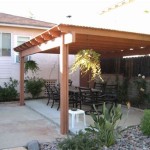Do You Seal Concrete Patio: A Comprehensive Guide
Concrete patios offer durability, versatility, and relatively low maintenance, making them a popular choice for outdoor living spaces. However, like all outdoor surfaces, concrete is vulnerable to weathering, staining, and wear. Consequently, the question of whether to seal a concrete patio often arises. This article provides a detailed exploration of the benefits, drawbacks, and considerations involved in sealing a concrete patio, enabling informed decision-making.
Sealing is the process of applying a protective coating to the concrete surface. This coating acts as a barrier, preventing or significantly reducing the penetration of water, oils, chemicals, and other substances that can damage or stain the concrete. Various types of sealers are available, each offering different levels of protection and aesthetic finishes. Understanding the properties of concrete and the purpose of sealing is crucial before proceeding.
Improved Durability and Longevity
One of the primary advantages of sealing a concrete patio is the enhanced durability and longevity it provides. Concrete, while strong, is porous. This porosity allows water to seep into the concrete matrix. During freeze-thaw cycles, this water expands as it freezes, exerting pressure on the concrete and leading to cracks, spalling (surface flaking), and overall deterioration. Sealing the patio prevents water from penetrating, thus mitigating the damaging effects of freeze-thaw cycles. This is especially critical in regions with harsh winters.
Moreover, concrete is susceptible to chemical attack from de-icing salts, fertilizers, and other common outdoor chemicals. These substances can react with the concrete, weakening its structure and leading to surface degradation. A sealer acts as a barrier, preventing these chemicals from reaching the concrete and causing damage. Regular application of a sealer can significantly extend the lifespan of the patio, protecting the initial investment.
Furthermore, sealing can enhance the patio's resistance to abrasion. Foot traffic, furniture movement, and even cleaning can gradually wear down the concrete surface. A sealer provides a protective layer that absorbs much of this wear, preserving the concrete's appearance and structural integrity. Some sealers are specifically formulated to enhance abrasion resistance, making them ideal for high-traffic areas.
Enhanced Aesthetic Appeal and Stain Resistance
Beyond its protective benefits, sealing a concrete patio can significantly improve its aesthetic appeal. Unsealed concrete is prone to staining from spills, dirt, and organic matter. These stains can be difficult, if not impossible, to remove completely, diminishing the patio's appearance. Sealing creates a barrier that prevents stains from penetrating the concrete, making them easier to clean. Regular cleaning and resealing can keep the patio looking new for years.
Sealants are available in a range of finishes, from matte to high-gloss, allowing homeowners to customize the patio's appearance. Some sealers are designed to enhance the natural color of the concrete, while others can add a subtle sheen or even a tinted color. This allows for greater design flexibility and the ability to complement the surrounding landscape and architecture.
Furthermore, sealing can help to prevent efflorescence, a white, powdery deposit that can appear on the surface of concrete. Efflorescence is caused by soluble salts migrating to the surface and reacting with carbon dioxide in the air. While not structurally damaging, efflorescence can be unsightly. A sealer can help to prevent these salts from reaching the surface, maintaining a clean and uniform appearance.
Reduced Maintenance and Easier Cleaning
Sealing a concrete patio reduces the overall maintenance required and simplifies cleaning. Unsealed concrete is more difficult to clean due to its porous nature. Dirt, grime, and spills can penetrate the surface, requiring more aggressive cleaning methods. Sealing creates a non-porous surface that is easier to wipe clean with mild soap and water. Regular sweeping and occasional washing are typically sufficient to maintain a sealed patio.
The reduced maintenance associated with sealed concrete can save time and effort. Homeowners can spend less time cleaning and more time enjoying their outdoor living space. The ease of cleaning also helps to prevent the build-up of mold and mildew, which can thrive in damp, porous concrete. This contributes to a healthier and more enjoyable outdoor environment.
Moreover, sealing can reduce the need for harsh chemical cleaners. Because stains are less likely to penetrate the surface, gentler cleaning methods are often sufficient. This is beneficial for both the environment and the concrete itself, as harsh chemicals can potentially damage the sealer over time.
Types of Concrete Sealers
Choosing the right type of sealer is essential for achieving the desired level of protection and aesthetic appeal. Several types of concrete sealers are available, each with its own unique properties and applications. The most common types include:
Acrylic Sealers: Acrylic sealers are relatively inexpensive and easy to apply. They provide a decent level of protection against water and stains and are available in a variety of finishes. However, acrylic sealers are not as durable as other options and may require more frequent reapplication.
Epoxy Sealers: Epoxy sealers offer excellent durability and resistance to chemicals and abrasion. They create a hard, glossy finish that is easy to clean. However, epoxy sealers can be more difficult to apply and may require professional installation. They are also more susceptible to UV degradation and may yellow over time if not properly protected.
Polyurethane Sealers: Polyurethane sealers are similar to epoxy sealers in terms of durability and chemical resistance. They are more flexible than epoxy sealers and are less likely to crack or chip. Polyurethane sealers are also more resistant to UV degradation. However, they can be more expensive than acrylic or epoxy sealers.
Penetrating Sealers: Penetrating sealers, such as silane and siloxane sealers, penetrate the concrete surface and react with the concrete to create a water-repellent barrier. They do not change the appearance of the concrete and are ideal for preserving a natural look. Penetrating sealers are durable and long-lasting but offer limited protection against stains.
The selection of a sealer should take into consideration the intended use of the patio, the climate, and the desired aesthetic finish. Consulting with a concrete professional can help in making an informed decision.
Application Considerations
Proper application is crucial for the effectiveness and longevity of a concrete sealer. Before applying any sealer, the concrete surface must be thoroughly cleaned and prepared. This typically involves removing any dirt, debris, oil stains, and existing coatings. Pressure washing is often used to clean the concrete, followed by etching to open the pores of the concrete and allow the sealer to penetrate properly.
The sealer should be applied according to the manufacturer's instructions. This typically involves applying one or more thin coats using a roller, brush, or sprayer. It is important to avoid applying too much sealer, as this can lead to bubbling or peeling. The sealer should be allowed to dry completely between coats and before allowing any traffic on the patio.
Weather conditions can also affect the application of a concrete sealer. It is best to apply the sealer on a dry, sunny day with temperatures within the recommended range. Avoid applying the sealer in direct sunlight or when rain is expected. The sealer should be allowed to cure completely before exposing the patio to water or heavy traffic.
Potential Drawbacks
While sealing offers numerous benefits, it is important to acknowledge potential drawbacks. Some sealers can alter the appearance of the concrete, which may not be desirable for all homeowners. High-gloss sealers, for example, can create a slippery surface when wet. It's important to choose a sealer that provides adequate slip resistance, especially in areas prone to moisture.
Furthermore, sealers require periodic reapplication. The frequency of reapplication depends on the type of sealer, the amount of traffic, and the environmental conditions. Regular inspection of the sealed surface is essential to identify any signs of wear or damage. When the sealer begins to wear down, it should be reapplied to maintain its protective properties.
Another potential drawback is the cost of sealing. While some sealers are relatively inexpensive, others can be quite costly. The cost of labor for professional application should also be considered. Homeowners should weigh the cost of sealing against the potential benefits, such as extended lifespan and reduced maintenance. They must also factor in the cost of maintenance of the sealer over time to determine actual cost.
Finally, improper application can lead to problems such as bubbling, peeling, and discoloration. It's crucial to follow the manufacturer's instructions carefully and to take the necessary precautions to ensure a successful application. If unsure, it is best to hire a professional concrete contractor with experience in sealing concrete patios.
In conclusion, the decision of whether to seal a concrete patio depends on several factors, including the climate, the intended use of the patio, and the homeowner's aesthetic preferences. Sealing can provide significant benefits in terms of durability, stain resistance, and reduced maintenance. However, it is important to choose the right type of sealer and to apply it properly. By carefully considering these factors, homeowners can make an informed decision that will enhance the beauty and longevity of their concrete patio.

Why You Should Seal Your Concrete Driveway Or Patio Gleam Team

7 Steps To Sealing Concrete Like A Pro Expert How Guide Network

How Often Should You Reseal Your Concrete Increte Of Houston

Concrete Stain And Sealer Patio Makeover Exchange

Importance Of Concrete Sealing In Louisiana

How Much Does Concrete Sealing Cost Guide

How To Re Seal A Stained Concrete Patio

Concrete Patio Sealer Gatorguard

Restoring Shine To Your Stained Concrete Patio

How To Seal Concrete Effectively Lowe S
Related Posts








